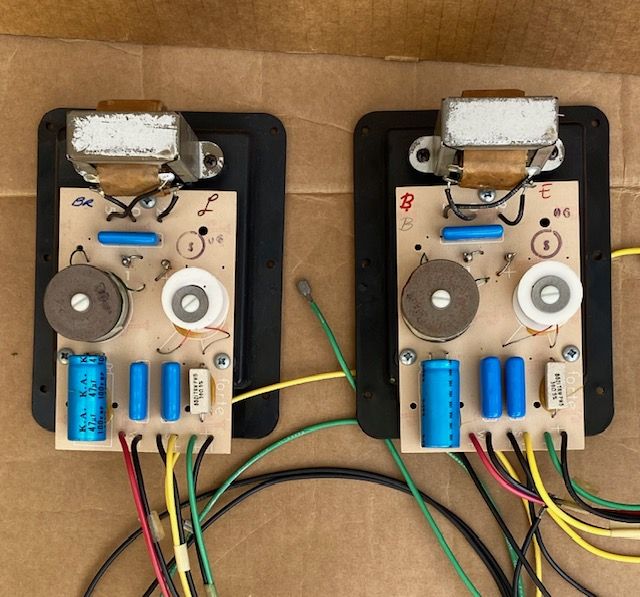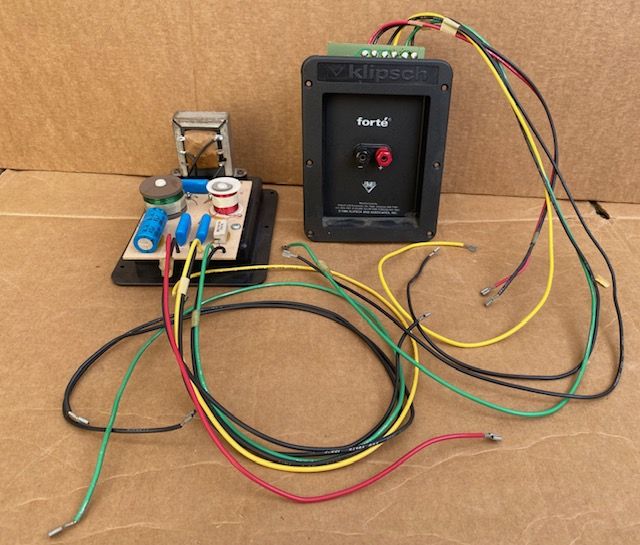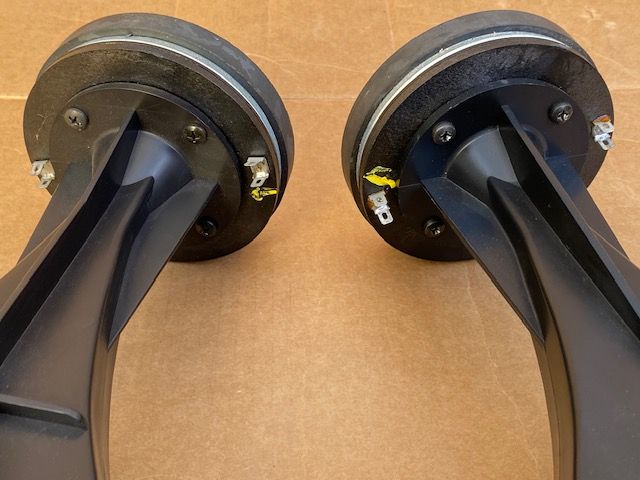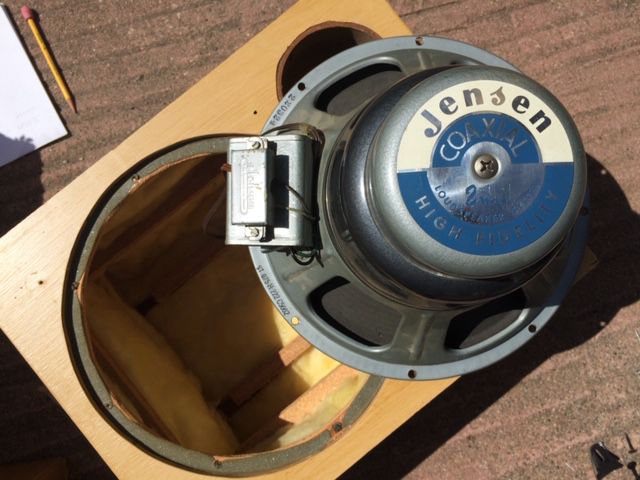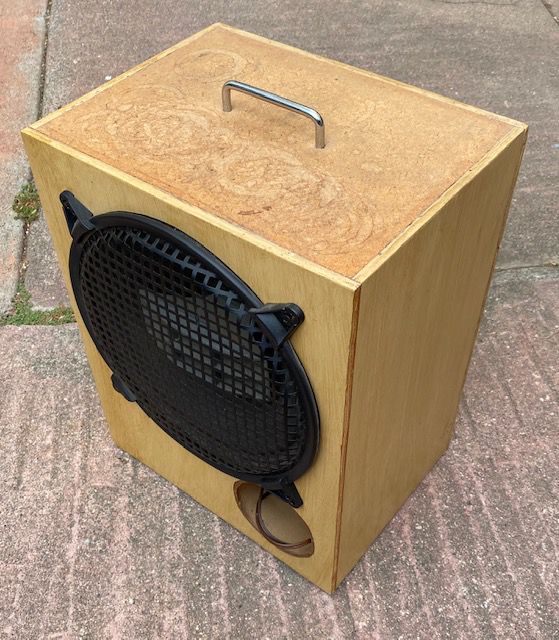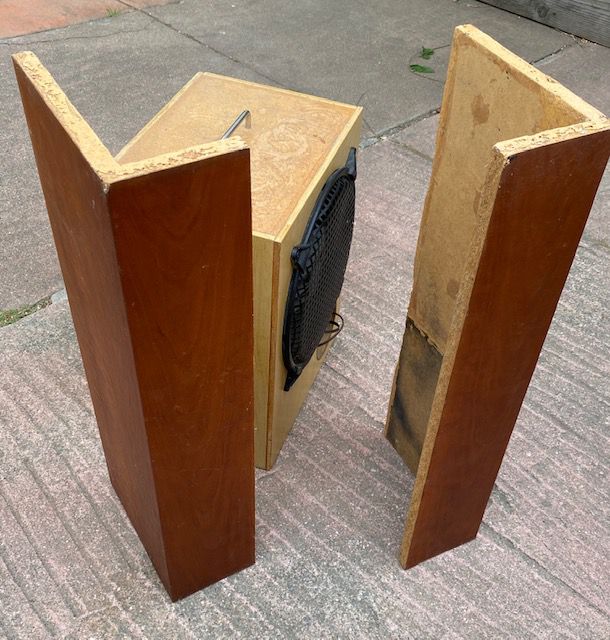-
Posts
24 -
Joined
-
Last visited
Content Type
Forums
Events
Gallery
Everything posted by Paul Hale
-
Pair of working original Klipsch x-overs from great sounding Forte 1. Wires in good shape. $80 cash only, local pick up preferred, Oakland, CA. (Can possibly meet in San Jose or Santa Rosa.)
-
Pair of original mid-horns from great sounding Forte 1 loudspeakers. K-53-K drivers, K-701 horns, 11 ohms. very good condition. $200 cash only, local pick up. (I can possibly meet in San Jose or Santa Rosa, too.)
-
Pair of nice 12" woofers from Heresy 1 speakers. K-22-R. Sounded very nice, smooth and warm. Very good condition (except for tarnished baskets). No holes or rips. I had soldered on Nordost wire to the terminals (Nordost 2-flat, high purity solid copper ribbon). There is white putty (easily removable) damping the terminal board (it was already well attached to the basket). $200 cash only, local pick up in Oakland, CA (I can possibly meet in San Jose or Santa Rosa).
-
12" K-23-K original Klipsch Forte 1 woofers. In very good condition, sounded good, no holes or rips. Paul in Oakland, CA $220 cash only, local pick up. (Can possibly meet in San Jose or Santa Rosa, too.)
-
Jensen 12" co-axial ST 875 H 222 for sale. Good condition, working, no holes or tears in cone. $160 cash, free local pick-up Oakland, CA. (no shipping). My father original owner. Had it in a Jensen CT-100 Concerto cabinet he made originally, then made this more portable vented cab. Some wood with nice veneer from the CT-100 cab available. Treble control actually works, but looks terrible. Also on craigslist sfbay.craigslist.org/eby/ele/d/oakland-jensen-12-vintage-co-axial/7226259428.html
-
Pair of Heresy I's for sale on craigslist. Oakland, Calif. $500 cash only. Crites woofers, new mid diaphragms, smooth impedance x-overs, cabinet bracing, etc.
-
I put new woofers from critesspeakers in my Heresy's (CW1228) and Fortes (CW1230), and this was a nice improvement in bass quantity (a bit), and especially bass quality in terms of timbral info, micro-dynamics, and spatial info. I recommend those, especially for replacing the old original Heresy I woofers. Looks like Moray is showing us the similarity of these woofers. There are many ways to hot-rod a Heresy.
-
Depending on your room dimensions, you may want to be careful about raising the woofer and passive to a height that is an even division of your ceiling height or wall spacing. For instance, you might get some real standing wave peaks if you raise the woofers up to 2' and your ceiling is 8'. An inexpensive way to experiment is to use various concrete building blocks and/or pavers to raise the speakers to various heights. Actually sounds pretty good, too. I'm currently enjoying using some modded Heresys on 6" x 8" x 16" cinder blocks painted brown, with 1/8" cork mat (from the hardware store) at floor/block and block/speaker interfaces. I stuffed the sideways pointing holes in the blocks with foam (didn't like the idea of having 4 tubes of the same dimensions right under the speakers). Also, I tried 1/2" footers under the front edges of the speakers, which seemed like an improvement. My Fortes sound better in my room (8' ceiling) with only the 1/2" feet in the front (Herbies teflon footers). Or yeah, just try some wood sticks under the front. The 1" half rounds work quite well. If you like 'em you can glue the flat side onto the speaker riser and have the round side on the floor. If you raise the Fortes much, you may also loose some bass, unless you can move them back closer to the corner.
-
Nordost 2-flat. Use a double run for the woofers, that is, two conductors for each + and - . Tie the wires down somewhere so they don't wiggle and vibrate inside the cab.
-
You could use 10 ohm with 22uF, or 12 ohms with 20uF. 10W resistor is probably OK unless you'll be blasting some really loud volumes. I used 12W Mills in that position which is fine. If you're using parts-express, I'd recommend the 1% Dayton caps. You could also use a 10 ohm resistor with a 20uF cap in parallel with a 1uF cap. If you're lucky, a pair of 20uF 5% Dayton caps could be close enough to each other, but I wouldn't want to use a 19uF cap in one speaker, and a 21uF cap in the other. The 1st order crossover is pretty forgiving, though. Erseaudio.com has some decent cheap crossover parts, caps at 3%. Something to be said for using inexpensive parts in your 1st crossover rebuild.
-
The leads from the 15 ohm/10W resistor are attached to the + and - screw-down terminals to the squawkwer, numbered 5, and 6 on the crossover board. This allows one to drop the horns down one numbered tap on the autoformer. It will give you a better balance with the woofer, and will let you hear if you might want to go further for a smooth impedance by spending the money on bigger (21uF) squawker capacitors. (The smooth impedance is probably good for most amps, but especially useful for low-powered tube amps with a high output impedance.) I think the other poster was talking about "risers" that raise the cabinet off of the floor a few inches and tilt them back a few degrees.
-
You could use the push on connectors, this would allow some experimentation. But with all the vibrating going on because of the darn music, a solder connection is much sturdier and will sound better in the long run. Woofers with push on connectors will often sound better with the wires soldered to the woofer terminals. You must use clean surfaces and heat sinks to be quick without overheating the rest of the woofer wiring and coil. Practice on throwaway connectors to gain experience. (Another reason to eshew push-ons is that you can minimize connections throughout your gear for better sound.) If your speakers already have push-on connectors to the autoformer, then it's an easy experiment. You must use one of two choices below for a resistor to be added! The T2A autoformer has taps 0 to 5. The (-)squawker wire is originally on tap 2. Moved (resoldered) to tap 1 drops the level 3dB. The (-)tweeter wire, also, should be moved (reconnected) from tap 3 to tap 2. You must add the 11 ohm 10W resistor and change the midrange cap to 21uF as shown in John Albright's post "Heresy 1 crossover upgrade." (Do an advanced search.) A simpler way to try the 3dB drop is reconnecting the wires to taps as mentioned above, but keep the same caps and put a 15 ohm 10 W resistor across the midrange connections on the board, connected from positive to negative on the midrange. That is described Albright's post, and other posts. Keep looking. There's a nice photo somewhere. You get the 3dB drop in the horns, but you don't get a smooth impedance curve for the speaker. Funny nobody mentioned another big reason the Heresy 1 can sound thin and shrill, it's the K77 tweeter. Many folks find it nasty sounding. For some, it would be the first thing to replace. (Bass was more important to me, which was why I went the way I did. I have a new Selenium tweeter to mount on the top, one of these days...) There is not much space to put a new type of tweeter in the cabinet. Critesspeakers has a drop in replacement. Sounds much better than the original.
-
Yes, thanks, djk! Coil I used is .18mH. (I'll try to correct the earlier post, too.)
-
I should add, that an ALK crossover would be a fine improvement, too, dropping the horns down and smoothing-out the huge midrange impedance peak.
-
TP143- Sorry, I'm coming into this thread a little late. I have worked on my Heresy 1's (and La Scalas and Fortes) and I do highly recommend changing the crossover, and the woofer. My Heresy's originally sounded as you discribed yours, thin and bright. They were designed to be bass-shy. If you haven't seen it yet, look for John Albright's post, Heresy 1 crossover upgrade. For me, putting the horns on different autotransformer taps (with the 11 ohm impedance swamping resistor and bigger midrange cap) that took them down 3dB made a huge improvement, and brought them closer to being a real stereo pair with more even frequency response. New caps in any old crossover is good improvement. I also put in the new woofers from critesspeakers, and I highly recommend this, too. Not only was the bass improved, but the timbre and detail of this range was improved, also, making for much better listening enjoyment. The Crites woofer is simply a much better woofer. I think my old woofers, which looked good, were soft and mushy. I used Albright's crossover design, but with a 3rd order Butterworth tweeter network, 2uF cap, to 1.8mH (correction: 0.18mH) shunt coil, to a 7uF cap to the tweeter. The Erse Super Q inductors are a good improvement over the old Klipsch woofer inductors. My old ones were terribly mis-matched, too. I also put new diaphrams in the mid drivers. This was a nice improvement, too, not as much an improvement with my speakers as the new woofer or dropping the horns down 3dB. I mostly enjoyed a little more body to the lower midrange, and a little more clarity and smoothness. I haven't put in the new tweeters, yet, one of these days.... A good subwoofer works very well with Heresy's (I would say they're essential, but I need bass down to 30 hz). I have a 10" Dayton Titanic III kit, and a Hsu VTF 2 MKIII. Either one helps out the Heresy's a lot, the Hsu VTF subs are quite good. Happy listening, Paul
-

External speaker cables vs. internal speaker cables
Paul Hale replied to lyeerluna's topic in Technical/Restorations
Hey tigerwkh, instead of wasting our time farting in our faces, why don't you share your experiences and knowledge with rewiring speaker drivers. -

External speaker cables vs. internal speaker cables
Paul Hale replied to lyeerluna's topic in Technical/Restorations
Don't use lamp cord from the hardware store. It's one of the worst wires you can use. Just because there's been a big scam with some cables doesn't mean you should simply buy the worst thing out there. And just because the speakers sound good now, doesn't mean they can't sound better. Continuing with the same cable external to internal makes sense, at least for the woofer. The tweeter carries much less current and doesn't benefit from a large gauge like the woofer does. What we want is a low resistance cable with clean high purity copper (or silver) with minimal grain boundaries. We want conductors with a smooth surface in tight but thin insulation with a low dielectric constant like teflon. We want minimal oxidation. We want minimal internal vibration of conductors. And we want good connections. At least use a high purity copper wire in teflon. Solid core wire benefits from having less surface area to oxdize, it's easier to have a tight insulation, and it makes for a better screw-down connection without an added soldered or crimped connector. (Actually, reducing the number of connections through-out a system is a good approach.) I like Nordost 2-Flat. It's a flat, thin (16g) high purity solid copper conductor in a thin white extruded teflon insulation. It has very low inductance, capacitance, and resistance. I compared it to several other cables including heavy gauge lamp cord, and I liked it best for good bass, instrumental timbres, and weighty transients. Seemed the most coherent. None of the stuff I tried was terribly expensive. (Now I make all my cabling.) Stripped back a half inch you have a spade for screw-down connection (one less connector). It makes great woofer wiring, with one exception. Like a lot of solid core wire, it wiggles and vibrates unless held down. I use dabs of silicon glue to hold it down, and one can try a loose wrap of teflon plumber's tape. It's been said in this forum before, that just making better connections inside the Forte (solder 'em) is one of the best upgrades. I figure, if I'm going to make better conncetions, I'll just use some better wire, too. Kimber cable is successful because it uses good copper conductors of different cross-section that fit tight in a thin teflon insulation. The weave minimizes vibration, emf noise and hum. Kimber and Neotech also sell very good solid core teflon coated wire. Lamp cord is designed for maximum flexibility, that's all. It has many low grade copper conductors with zillions of grain boundaries loose packed in a thick insulation with a high dielectric constant that blurs the signal. Imagine all these oxidized wires vibrating against each other. Not great for conducting delicate music signals. All of the original crossover parts in the Forte are lousy. Sonicaps are a good replacement, and so are the Erse Super Q inductors for the woofer. Best thing is to make a new crossover with the parts on a board that can be mounted on an inside wall, or mounted on the back, covering the hole where the terminal cup was, or mounting it in the hollow base. I have my own new Forte crossover parts laid out, have yet to mount them.... Critesspeakers.com makes a new crossover, and so does DeanG and popbumper. Put in some decent wire with really good solder connections, then have a beer. Happy listening! -
The lighter ones may actually be best if they're in an aluminum can, as opposed to a steel can (heavier). Most of the GE motor runs I've come across were in aluminum cans, which may be good for a crossover that's anywhere near big magnets. Also I haven't had any GE caps that looked like they had been leaking. New GE's were relatively expensive motor runs, and may be among the best built. I think they sound pretty good, especially in tube amp power supplies. I've used 'em in Klipsch crossovers to good effect, too, but it just could be that they were simply newer and better caps than the old leaky originals they replaced. I've gotten most of my motor runs from local surplus stores. The advantage of seeing them first is to note whether they're used or new (appearance of the terminals), note the production date, and guess if they've been leaking by checking for any oily residue near the terminals. You can also hold them close to your ear and tap on them to guess at the fluid content, but of course you don't want anyone to see you listening to caps in this fashion.... Too bad most of these otherwise high quality cheap (from surplus) poly caps have steel connecting terminals (the GE's too), and are in steel cans. If you're into experimenting, the push-on terminals allow you to exchange caps without soldering.
-

I know its a lot to ask... Heresy I crossovers
Paul Hale replied to carbon summit's topic in Technical/Restorations
I'll vouch for the mods, too. A few months ago I rebuilt a pair of Heresy I speakers, and used something like John Albright's Type E modified network with the 20uF midrange cap and the 11 ohm impedance-smoothing resistor. The character of the speaker was transformed into something much better. (Thanks, John!) This is especially good for most tube amps to have the impedance smoothed out. Highly recommended by this listener. One could do this to the E-2 network, also. -

FINALLY DONE--210hz "KEVHORNS"-pics added 1-30
Paul Hale replied to kevinmi's topic in Technical/Restorations
Awesome! Beautiful! -PH -
Part of "gear synergy" is considering the many parameters affecting the tube inside the amp. High voltage on the plate is one of the main ones. To answer one of the original questions, one of the differences between a 6550 and a KT88 is that the KT88 is a high voltage tube. It is built to operate under higher voltages. Gartenman, I didn't say anything about the sound of higher voltage ratings, I was talking about safety and survival. Sorry I wasn't more clear. But if you want to consider just the sound, I'd say that wired in triode with 525 volts on the plate, a KT88 will sound better than a 6550 that's burned up. There are plenty of amps with less than 400 volts on the output tube plates, also. It's just good to know what you have. The 6DJ8 wasn't designed for audio, either, but it's used in many amps. Old Telefunken 12AX7s may sound good in vintage gear. I'd like to offer a clarification that they may sound good in vintage gear with high frequency rolloff that has old worn out capacitors with no highs. To many, they're thin and bright, but can sound "clear." Joe says the same in his "Tube Lore." If you've got a rebuilt vintage amp with new caps and maybe a few small circiut updates, a new reissue Tungsol and/or a LPS can sound great. The original poster said money was an issue, which made me want to offer the advice of new production tubes. But I'm no guru. Just trying to help. A reliable tube guide would be nice, but there sure are a lot of variables (amp, system, music, ears, room). I guess that's part of the fun, finding what tubes work well for you. Don't be in a hurry. PH
-
Wow, you guys are talking about some very expensive tubes. For a lower cost alternative, you should consider some new production tubes, some of which sound very good. I've really liked the Sovtek 12AX7LPS for phono stage. It's very quiet (spiral filament) and rich sounding (unlike many other Sovteks). The reissue Tungsol 12AX7 is a great sounding tube. Big strong punchy and rich. I'm using the LPS in phono and the Tungsol in the line stage in a rebuilt Dyna PAS. A good combo, I think. Totally quiet with LaScalas. I had bad luck with a lot of '80s Philips 12AX7s. Didn't sound nice, kinda thin, and noisy. 12AT7 are cheaper. You can get old black plates reasonably. The new EH 12AT7 sound OK, pretty quiet, too. I don't use 12ATs much.... I've used Valve Art KT88 and they sounded very good. Better bass, more realistic that EH or SED in my amps. But the latest Chinese KT88s have supposedly slipped a lot in quality(?). Wired as triodes, KT88s are probably better than 6550 because they have a higher screen voltage rating. Gold Lions are supposed to be excellent, but very expensive. Jim McShane is a good guy to deal with. Has new and old tubes. You can also experiment with his "almost NOS" used tubes. PH
-
Yes, I read that thread a couple of times. Thanks for all of your work, on the Forte, and also on the Heritage line as well. Great to see some of those graphs. Most of us don't have test equipment like yours. Too bad there was so little to say about the sound. Anyone out there build these networks? I'm after a simpler crossover. Something like John Albright's Heresy Type E Modified crossover for the Forte with a 3rd order tweeter filter. He posted a schematic of it here somewhere. I put that in my Hereys with a 3rd order Butterworth for the tweeter as above, and I really like it. Really transformed the speakers into something balanced and rich with my little tube amps. Many thanks, John! And while I'm thanking people, I'd like to extend thanks to DeanG, BEC, djk, and so many others who have posted great info and projects on this site. My first post but I've been reading, I've learned a lot, and learned that there's so much more to learn on just this site, if I can just find it.... An ALK Jr Forte network would be nice to see, too! I guess I'll report back in a couple of months (pretty busy here) after I put together a new crossover in the base where I can adjust the autotransformer taps, midrange polarity, and the mid cap. -Paul
-
I would like to build a new crossover into the hollow base of my Forte speakers. I have used swamping resistors in my LaScalas and Heresys (with the appropriately larger mid cap) and liked the result a lot. If I use a 10 ohm swamper in the Forte network, what would the experienced crossover builders have to recommend for a midrange cap value? I'm figuring 24uF for C in my drawing below (I hope I get the attachment to work). I'd like to keep it a simple network like the original. I'll use a new Crites 3636 autotransformer to be able to adjust the mid and tweeter a db or two. I didn't draw it in, but II'll probably try putting the tweeter through the 3636, also. And I'll use a 3rd order Butterworth for the tweeter. Any suggestions most welcome. Paul


